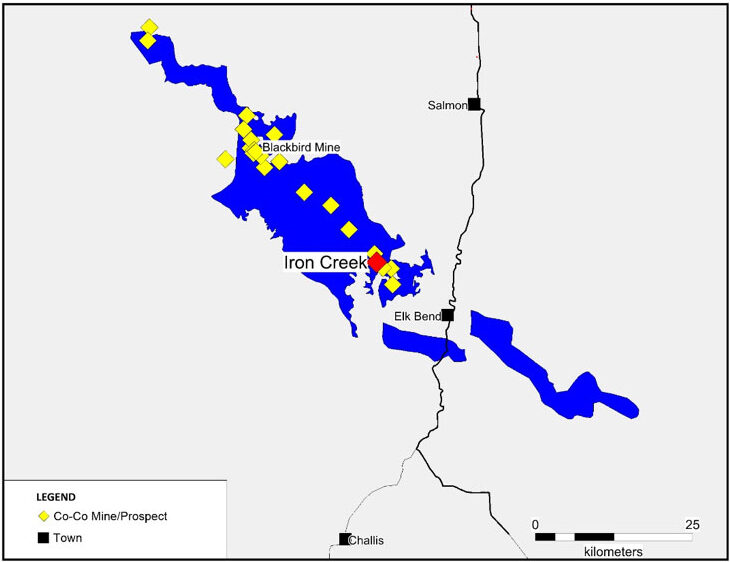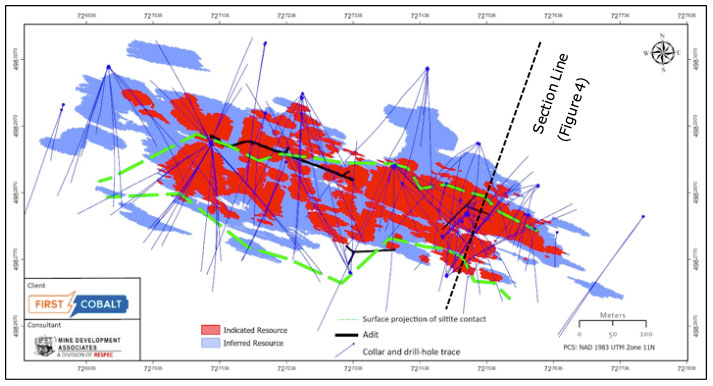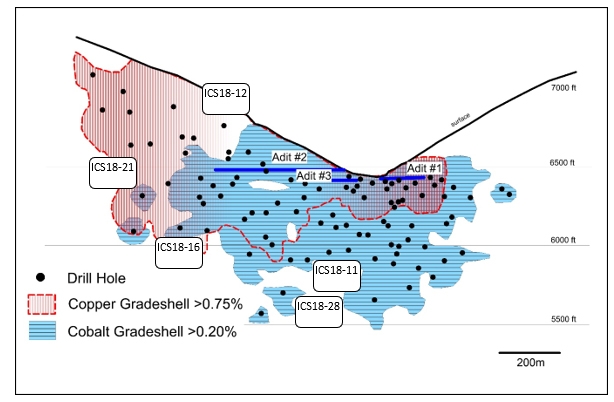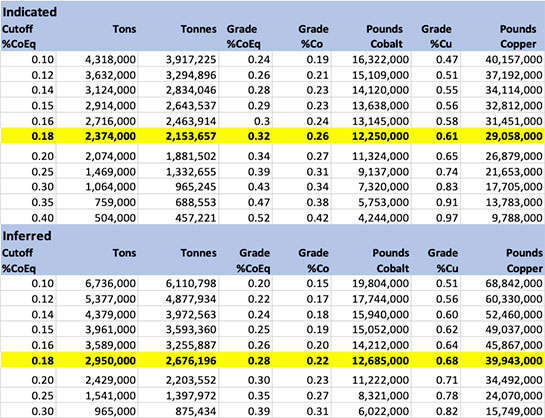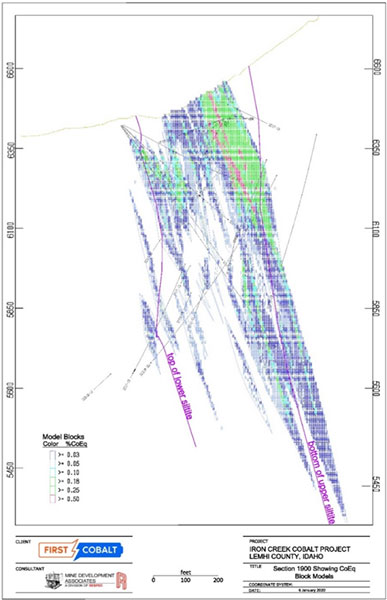Iron Creek - Idaho
The Iron Creek Cobalt Project is located in Lemhi County, Idaho, USA, along the most prolific trend of cobalt mineralization in the USA that includes the historic Blackbird Mine, the Idaho Cobalt Belt (Figure 1). The property consists of mining patents and exploration claims covering an area of 1,698 acres. Discovered in 1946, then explored extensively in 1970 to 1972, the area has been relatively dormant since 2017. First Cobalt has completed over 29,000m of diamond drilling resulting in an updated NI43-101 compliant resource estimate. Significant infrastructure is in place to support multiple drills and underground activity for further work. Historic underground development includes 600 metres of drifting from three adits and an all-weather road connecting the project to a state highway.
Figure 1. Location of Iron Creek Project and Idaho Cobalt Belt.
2019 Mineral Resource Estimate
First Cobalt published the first NI43-101 compliant report on Iron Creek cobalt-copper resources in 2018.
In 2019, First Cobalt finalized an infill drill program focused on upgrading the maiden resource estimate from 2018. The drill program completed 43 surface and underground holes for a total of 13,434m. A NI43-101 compliant Mineral Resource estimate was published in January 2020 based on geological and structural data from 105 diamond drill holes for a total of 28,563 metres and approximately 21,500 geochemical samples collected by First Cobalt between 2017 and 2019.
The updated estimate effective November 27, 2019 has calculated Indicated Resource of 2.2 million tonnes at 0.32% cobalt equivalent (0.26% cobalt and 0.61% copper) for 12.3 million pounds of contained cobalt and 29 million pounds of contained copper as well as an Inferred Resource of 2.7 million tonnes at 0.28% cobalt equivalent (0.22% cobalt and 0.68% copper) for an additional 12.7 million pounds of contained cobalt and 40 million pounds of contained copper
Highlights Described in the Report
- Infill drilling and limited step-out drilling has upgraded 49% of the maiden resource estimate from Inferred to Indicated while tonnage has increased by 10% (Figure 2).
- Drilling has outlined the strike extent of mineralization to over 950m and down-dip to over 300m and mineralization remains open in all directions, suggesting strong potential for significant future resource growth.
- Surface holes at the western portion of the resource confirmed the extension and continuity of higher-grade copper mineralization, greater than 0.75%. Chalcopyrite stringers are also found in the stratigraphic hangingwall that represent the discordant nature of copper mineralization and may be targeted in future exploration programs (Figure 3).
- Upgrading the resource to a higher confidence level did not result in a decrease in the resource grade, highlighting the strong continuity of mineralization.
- Thick mineralized zones of up to 30m of true thickness reflect broad stratabound lithological controls rather than discrete horizons as previously modelled (Figure 4).
- Previous distinctions between the No Name and Waite zones are no longer applicable as mineralization was consistently intersected between the two areas and into the hangingwall.
- No new metallurgical tests have been completed since 2018, but initial testing concludes that simple flotation methods are applicable, yielding recoveries of 96% for cobalt and 95% for copper in rougher floatation
Table 1 outlines the calculations of Indicated and Inferred Resources. Highlighted in yellow are those resources where all material within contiguous bodies are most likely minable underground and at a cutoff of 0.18%CoEq with “reasonable prospects for eventual economic extraction”.
Figure 2. Distribution of Indicated and Inferred cobalt-copper resources at Iron Creek (view from above to show full extent of drilling).
Figure 3. Schematic long section through the Iron Creek resources showing independent cobalt and copper grade shells.
Table 1. Calculated resource estimates at Iron Creek.
Notes
- Mineral Resources, which are not Mineral Reserves, do not have demonstrated economic viability. The Inferred Mineral Resource in this estimate has a lower level of confidence than that applied to an Indicated Mineral Resource and must not be converted to a Mineral Reserve. It is reasonably expected that the majority of the Inferred Mineral Resource could be upgraded to an Indicated Mineral Resource with continued exploration. The Mineral Resources in this press release were estimated using the Canadian Institute of Mining, Metallurgy and Petroleum (CIM), CIM Standards on Mineral Resources and Reserves, Definitions and Guidelines prepared by the CIM Standing Committee on Reserve Definitions and adopted by CIM Council.
- Grade cutoff for both Indicated and Inferred Resources is 0.18% Co Eq calculated as %Co + %Cu÷10
- The cutoff grade utilized in the above table was derived from US$30/lb Co and US$3/lb Cu consistent with the 2018 resource estimate.
- Three types of statistical estimates were completed: nearest neighbour, inverse distance, and kriging. Each method was run several times in order to determine sensitivity to estimation parameters as well as evaluate and optimize the results. Results using the inverse distance estimate are here.
- Block size, 10ft long along strike, 5ft across, and 10ft high, reflect probable mining extraction dimensions.
- Technical and economic factors likely to influence the “reasonable prospects for eventual economic extraction” were evaluated using the best judgement of Mr. Steven J. Ristorcelli, C.P.G., Principal Geologist for Mine Development Associates and a Qualified Person under NI 43-101. Potential for underground mining was assessed by running stope optimizations using mining costs, processing costs, and anticipated metallurgical recoveries for similar size operations in the western United States.
Figure 4. Cross section of the CoEq block model grades showing typical thickness of mineralization and relationship to lithological contacts. Section is 100 feet (33m) thick and view is toward southwest (West 20o South) along the strike trend of mineralization. Block sizes are 10ft along strike, 5ft across, and 10ft high.
Click here for Iron Creek Technical Report
Drilling Highlights 2018-2019 and Resource Cross Sections
Click here for Drilling Highlights 2018-2019
and Resource Cross Sections


